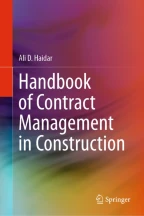
This chapter will look at the main standard forms of contract that are being used in the USA, the UK and in other countries, focusing, of course, on the most popular form—the FIDIC contract. The purpose of standard forms of contract is to facilitate the contractual arrangements between parties in a construction project. Standard forms of contract offer ready-made terms and conditions when one is making a contract. These standards are commonplace in construction transactions and generally accepted by the different contracting parties. The literature on standard form contracts in construction has increased dramatically in recent years as they are becoming more and more popular due to their ease of use and the fact that employers and contractors are becoming familiar with their use. They also provide a good platform to start a contract and are written so that changes can easily be made to them in the form of special (particular) conditions without changing the general terms and conditions.
This is a preview of subscription content, log in via an institution to check access.
eBook EUR 74.89 Price includes VAT (France)
Softcover Book EUR 94.94 Price includes VAT (France)
Hardcover Book EUR 137.14 Price includes VAT (France)
Tax calculation will be finalised at checkout
Purchases are for personal use only
Contracts of these kinds affect not only the actual parties that are party to them, but also others who may have an interest in the transactions to which they relate.
Also called ‘special condition’.AIA A101–2017 is a standard form of agreement between owner and contractor for use where the basis of payment is a stipulated sum or fixed price. A101 adopts by reference, and is designed for use with, AIA Document A201–2017, General Conditions of the Contract for Construction.
AIA A201–2017 is adopted by reference in owner/architect, owner/contractor, and contractor/subcontractor agreements in the Conventional (A201) family of documents.
Engineer, architect, consultants and client.Approximately 20 construction associations, including the Associated General Contractors of America, Associated Builders and Contractors, The American Subcontractors Association, The Construction Users Roundtable, The National Roofing Contractors Association, The Mechanical Contractors Association of America, and the Plumbing-Heating-Cooling Contractors Association participated in developing the ConsensusDOCS, and endorsed them.
ICE is an independent engineering institution and represents approximately 80,000 civil engineers worldwide. Principal membership is in the United Kingdom, but it has memberships in China, Hong Kong, Russia, India and roughly 140 other countries.
In 2011, ICE withdrew from the ICE Conditions of Contract and its clientship was transferred to the Association for Consultancy and Engineering (ACE) and the Civil Engineering Contractors Association (CECA), and the contracts were rebranded as the Infrastructure Conditions of Contract.
In 1994 the Latham Report Constructing the Team was published. The report was commissioned by the UK government to investigate the perceived problems with the construction industry.